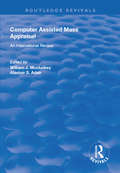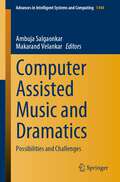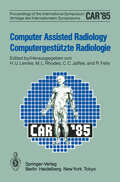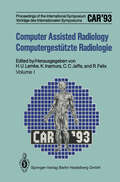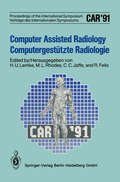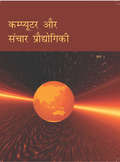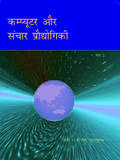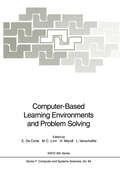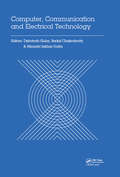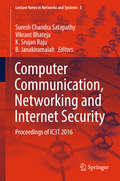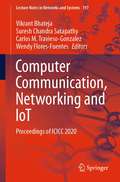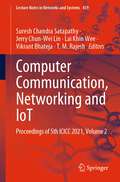- Table View
- List View
Computer Assisted Mass Appraisal: An International Review (Routledge Revivals)
by William J. McCluskey Alastair AdairFirst published in 1997, this volume emerged in response to the need for material on the research, development, use and application of mass appraisal techniques for ad valorem property tax systems. The primary paradigms discussed include regression, base home technique, adaptive estimation procedure and artificial neural networks. Intending to address a wide range of property types, the authors explored residential, condominiums, retail, office and industrial property as well as agricultural and forestry land.
Computer Assisted Music and Dramatics: Possibilities and Challenges (Advances in Intelligent Systems and Computing #1444)
by Ambuja Salgaonkar Makarand VelankarThis book is intended for researchers interested in using computational methods and tools to engage with music, dance and theatre. The chapters have evolved out of presentations and deliberations at an international workshop entitled Computer Assisted Music and Dramatics: Possibilities and Challenges organized by University of Mumbai in honour of Professor Hari Sahasrabuddhe, a renowned educator and a pioneering computational musicologist (CM) of Indian classical music. The workshop included contributions from CM as well as musicians with a special focus on South Asian arts. The case studies and reflective essays here are based on analyses of genres, practices and theoretical constructs modelled computationally. They offer a balanced and complementary perspective to help innovation in the synthesis of music by extracting information from recorded performances. This material would be of interest to scholars of the sciences and humanities and facilitate exchanges and generation of ideas.
Computer Assisted Radiology / Computergestützte Radiologie: Proceedings of the International Symposium / Vorträge des Internationalen Symposiums
by AMK BerlinNew imaging technology and more sophisticated image processing systems will have a profound effect on those areas of medicine which are concerned with imaging for diagnosis and therapy planning. Digitally formated data will form the basis of an increasing number of medical imaging modalities. Before the diagnostic imaging department of the future will largely be digital, many problems have still to be solved as regards image quality, costs, and ease of use. The computer and other information science derived methods will contribute towards solving many of the problems in these areas. It is widely expected that there will be an information science derived evolution in imaging for radiology and related departments. Computer assistance may be applied to image generation, e.g. CT, MRI, DR and DSR, storing and transferring of images, and viewing, analysing and interpreting of images. The application of computers to these activities (which characterise radiological departments), may be defined as Computer Assisted Radiology (CAR) . In the main, CAR will promote the transition from analog imaging systems to digital systems, integration of digital imaging modalities through Picture Archiving and Communication Systems (PACS') and the graduated employment of Medica~ Work Stations (MWS) for diagnosis and therapy planning. It will transfer geographically, organisationally and/or mentally isolate imaging activities towards fully integrated multi-imaging modality diagnostic departments. This development will have a considerable impact on patient management, on the medical profession and on the health care system.
Computer Assisted Radiology / Computergestützte Radiologie: Proceedings of the International Symposium / Vorträge des Internationalen Symposiums CAR'93 Computer Assisted Radiology
by Heinz U. LemkeCAR is a symposium and exhibition covering the impact of computer and communication systems applied to radiology and other medical disciplines, which use digital imaging for diagnosis and therapy planning. CAR '93 also provides tutorials, but more emphasis is given to a broad variety of specific problems related to medical/technical issues in digital imaging. This is achieved through in-depth presentations of results of current medical imaging projects on a worldwide basis.
Computer Assisted Radiology / Computergestützte Radiologie: CAR '91 Computer Assisted Radiology
by Heinz U. Lemke Michael L. Rhodes C. C. Jaffe Roland FelixCAR is a symposium and exhibition covering the impact of computer and communication systems applied to radiology and other medical disciplines, which use digital imaging for diagnosis and therapy planning. CAR '91 also provides tutorials, but more emphasis is given to a broad variety of specific problems related to medical/technical issues in digital imaging. This is achieved through in-depth presentations of results of current medical imaging projects on a worldwide basis.
Computer Aur Sanchaar Prodhogiki Bhag 1 class 11 - NCERT Board: कम्प्यूटर और संचार प्रौद्योगिकी भाग 1 कक्षा 11 - एनसीईआरटी
by Rashtriy Shaikshik Anusandhan Aur Prashikshan Parishadकम्प्यूटर और संचार प्रौद्योगिकी भाग 1 कक्षा 11 वीं का पुस्तक हिंदी भाषा में राष्ट्रीय शैक्षिक अनुसंधान और प्रशिक्षण परिषद् ने प्रकाशित किया गया है । इस पाठ्यपुस्तक में छ: विषय-वस्तुओं/ यूनिटों के अंतर्गत चौदह अध्याय हैं, अर्थात् कम्प्यूटर तथा संचार प्रौद्योगिकी (Computer and Communication Technology - CCT) के संसार में स्वागत; कार्यस्थल उत्पादकता उपकरण संचार अवधारणाएं एवं कुशलताएँ; वेब प्रकाशन प्रौद्योगिकी; सामूहिक कार्य (टीमवर्क) तथा वेब आधारित सहयोग उपकरण और उभरती हुई प्रौद्योगिकियाँ। यह पुस्तक निष्ठापूर्वक तैयार की गई है और पाठ्यपुस्तक विकास समूह, स्कूलों के अध्यापक, विषय विशेषज्ञ, शिक्षाविद् और सरकारी, गैर-सरकारी तथा निजी संस्थाओं / संगठनों के तकनीकी विशेषज्ञ के सतत प्रयासों का परिणाम है । छात्र उच्च माध्यमिक स्तर के बाद भी कम्प्यूटर के बारे में अध्ययन जारी रख सकते हैं और नहीं भी, किंतु ऐसा प्रतीत होता है कि वे सीसीटी के पीछे निहित तर्क को किसी भी अन्य शाखा में उपयोगी पाएँगे, चाहे वह प्रशासन हो, सामाजिक विज्ञान हो, पर्यावरण, अभियांत्रिक (इंजीनियरिंग), प्रौद्योगिकी, जैविकी, चिकित्सा या ज्ञान की कोई भी अन्य शाखा हो ।
Computer Aur Sanchaar Prodhogiki Bhag 2 class 11 - NCERT Board: कम्प्यूटर और संचार प्रौद्योगिकी भाग 2 कक्षा 11 - एनसीईआरटी
by Rashtriy Shaikshik Anusandhan Aur Prashikshan Parishadकम्प्यूटर और संचार प्रौद्योगिकी भाग 2 कक्षा 11 वीं का पुस्तक हिंदी भाषा में राष्ट्रीय शैक्षिक अनुसंधान और प्रशिक्षण परिषद् ने प्रकाशित किया गया है । इस पाठ्यपुस्तक में छ: विषय-वस्तुओं/ यूनिटों के अंतर्गत चौदह अध्याय हैं, अर्थात् कम्प्यूटर तथा संचार प्रौद्योगिकी (Computer and Communication Technology - CCT) के संसार में स्वागत; कार्यस्थल उत्पादकता उपकरण संचार अवधारणाएं एवं कुशलताएँ; वेब प्रकाशन प्रौद्योगिकी; सामूहिक कार्य (टीमवर्क) तथा वेब आधारित सहयोग उपकरण और उभरती हुई प्रौद्योगिकियाँ। यह पुस्तक निष्ठापूर्वक तैयार की गई है और पाठ्यपुस्तक विकास समूह, स्कूलों के अध्यापक, विषय विशेषज्ञ, शिक्षाविद् और सरकारी, गैर-सरकारी तथा निजी संस्थाओं / संगठनों के तकनीकी विशेषज्ञ के सतत प्रयासों का परिणाम है । छात्र उच्च माध्यमिक स्तर के बाद भी कम्प्यूटर के बारे में अध्ययन जारी रख सकते हैं और नहीं भी, किंतु ऐसा प्रतीत होता है कि वे सीसीटी के पीछे निहित तर्क को किसी भी अन्य शाखा में उपयोगी पाएँगे, चाहे वह प्रशासन हो, सामाजिक विज्ञान हो, पर्यावरण, अभियांत्रिक (इंजीनियरिंग), प्रौद्योगिकी, जैविकी, चिकित्सा या ज्ञान की कोई भी अन्य शाखा हो ।
Computer-Based Automation
by Julius T. TouIt has been recognized that productivity improvement is an important issue of the 80' s. It is regarded as the most efficient way to improve national economy and to enrich the quality of life. The key to productivity improvement is advanced automation, especially computer-integrated automation for engineering design and office operations as well as manufacturing processes. This is the theme of 1983 International Conference on Advanced Automation, ICAA-83. This book contains the articles which are the revised and updated version of the papers presented at the ICAA-83 Conference. Traditionally, automation is synonymous with mechanization; but this Conference has treated automation from a different point of view. We consider automation as a process to unify various automated information processing systems for performing business, administration, design, engineering and manufacturing functions, in addition to the traditional fixed automation in production. In other words, design automation and office automation form an inte gral part of factory automation to accomplish comprehensive computer-integrated manufacturing and production. In engineering and manufacturing today, quality design and high productivity are synonymous with the use of computers, robots, expert systems, and other computer-based technologies. The greater the degree of computer-based automation exploited and implemented, the greater a nation's ability to survive in tomorrow's extremely competitive world market.
Computer-Based Diagnostic Systems (Practitioner Series)
by Chris PriceThis book addresses the issue of the best way to build effective knowledge-based systems for handling different types of diagnostic problems. It presents examples of different solutions to building effective diagnostic systems, and helps the reader to decide on an appropriate strategy for building a system. The book makes the material easy to understand and goes through the different options for constructing diagnostic systems.
Computer-Based Diagnostics and Systematic Analysis of Knowledge
by Dirk Ifenthaler Pablo Pirnay-Dummer Norbert M. SeelWhat is knowledge? How can it be successfully assessed? How can we best use the results? As questions such as these continue to be discussed and the learning sciences continue to deal with expanding amounts of data, the challenge of applying theory to diagnostic methods takes on more complexity. Computer-Based Diagnostics and Systematic Analysis of Knowledge meets this challenge head-on as an international panel of experts reviews current and emerging assessment methodologies in the psychological and educational arenas. Emphasizing utility, effectiveness, and ease of interpretation, contributors critically discuss practical innovations and intriguing possibilities (including mental representations, automated knowledge visualization, modeling, and computer-based feedback) across fields ranging from mathematics education to medicine. These contents themselves model the steps of systematic inquiry, from theoretical construct to real-world application: Historical and theoretical foundations for the investigation of knowledge Current opportunities for understanding knowledge empirically Strategies for the aggregation and classification of knowledge Tools and methods for comparison and empirical testing Data interfaces between knowledge assessment tools Guidance in applying research results to particular fields Researchers and professionals in education psychology, instructional technology, computer science, and linguistics will find Computer-Based Diagnostics and Systematic Analysis of Knowledge a stimulating guide to a complex present and a rapidly evolving future.
Computer-Based Instruction in Military Environments (Nato Asi Subseries B: Ser. #209)
by Robert J. Seidel P. D. WeddleThis collection of papers is the result of a symposium sponsored by NATO's Defense Research Group Panel VIII in the Spring of 1985. The symposium came into being when it became obvious to the NATO countries that research, development and utilization of advanced technologies for training was the best means of increasing both training effectiveness and efficiency. This symposium was the second in a series of three devoted to training. The series was structured to cover all aspects of training. The first series addressed the value of training, the second one dealt with the application of training technologies and the third and last of the series focused on academic issues concerned with the effect of prior learning on subsequent learning. The fact that a major American publisher has determined that computer based instruction is the technology of greatest interest to the NATO community is not surprising. Advances in microprocessor technology have revolutionized both how and where we train. During this symposium there were a limited number of carefully chosen exhibits to demonstrate the various applications of computer based training techniques. In the following papers you will find both a practical and scientific basis for the way current and future training and training systems should be designed, applied and utilized. We know that training must be done faster and more effectively.
Computer-Based Learning Environments and Problem Solving (NATO ASI Subseries F: #84)
by Erik De Corte Marcia C. Linn Heinz Mandl Lieven VerschaffelMost would agree that the acquisition of problem-solving ability is a primary goal of education. The emergence of the new information technologiesin the last ten years has raised high expectations with respect to the possibilities of the computer as an instructional tool for enhancing students' problem-solving skills. This volume is the first to assemble, review, and discuss the theoretical, methodological, and developmental knowledge relating to this topical issue in a multidisciplinary confrontation of highly recommended experts in cognitive science, computer science, educational technology, and instructional psychology. Contributors describe the most recent results and the most advanced methodological approaches relating to the application of the computer for encouraging knowledge construction, stimulating higher-order thinking and problem solving, and creating powerfullearning environments for pursuing those objectives. The computer applications relate to a variety of content domains and age levels.
Computer-based Modelling and Optimization in Transportation (Advances in Intelligent Systems and Computing #262)
by Jorge Freire Sousa Riccardo RossiThis volume brings together works resulting from research carried out by members of the EURO Working Group on Transportation (EWGT) and presented during meetings and workshops organized by the Group under the patronage of the Association of European Operational Research Societies in 2012 and 2013.The main targets of the EWGT include providing a forum to share research information and experience, encouraging joint research and the development of both theoretical methods and applications, and promoting cooperation among the many institutions and organizations which are leaders at national level in the field of transportation and logistics.The primary fields of interest concern operational research methods, mathematical models and computation algorithms, to solve and sustain solutions to problems mainly faced by public administrations, city authorities, public transport companies, service providers and logistic operators. Related areas of interest are: land use and transportation planning, traffic control and simulation models, traffic network equilibrium models, public transport planning and management, applications of combinatorial optimization, vehicle routing and scheduling, intelligent transport systems, logistics and freight transport, environment problems, transport safety, and impact evaluation methods.In this volume, attention focuses on the following topics of interest:· Decision-making and decision support · Energy and Environmental Impacts· Urban network design· Optimization and simulation· Traffic Modelling, Control and Network Traffic Management· Transportation Planning· Mobility, Accessibility and Travel Behavior· Vehicle Routing
Computer Chess Compendium
by D. LEVYFor many years I have been interested in computer chess and have collected almost every learned paper and article on the subject that I could find. My files are now quite large, and a considerable amount of time, effort and expense has been required to build up this collection. I have often thought how difficult it must be for many computer chess enthusiasts to acquire copies of articles that they see referenced in some other work. Unless one has access to a good reference library, the task is almost impossible. I therefore decided to try to make available, in one volume, as many as possible of the most interesting and important articles and papers ever written on the subject. Such a selection is naturally somewhat subjective, and I hope that I will not offend authors whose works have been excluded. In particular I have decided to exclude any material which has appeared in the Journal of the International Computer Chess Association (ICCA), or in its precursor, the ICCA Newsletter. The reason is simply that the ICCA itself is in the process of compiling a compendium containing the most important material published in those sources. For further information on ICCA membership and publications the reader is invited to contact: Professor H. 1. van den Herik, or Dr Jonathan Schaeffer University of Limburg, Computing Science Dcpaitment, Department of Computer Science University of Alberta, 6200 MD Maastricht Edmonton Netherlands Alberta, Canada T6G 2HI.
Computer, Communication and Electrical Technology: Proceedings of the International Conference on Advancement of Computer Communication and Electrical Technology (ACCET 2016), West Bengal, India, 21-22 October 2016
by Debatosh Guha; Badal Chakraborty; Himadri Sekhar DuttaThe First International Conference on Advancement of Computer, Communication and Electrical Technology focuses on key technologies and recent progress in computer vision, information technology applications, VLSI, signal processing, power electronics & drives, and application of sensors & transducers, etc. Topics in this conference include: Computer ScienceThis conference encompassed relevant topics in computer science such as computer vision & intelligent system, networking theory, and application of information technology. Communication EngineeringTo enhance the theory & technology of communication engineering, ACCET 2016 highlighted the state-of the-art research work in the field of VLSI, optical communication, and signal processing of various data formatting. Research work in the field of microwave engineering, cognitive radio and networks are also included. Electrical TechnologyThe state-of-the-art research topic in the field of electrical & instrumentation engineering is included in this conference such as power system stability & protection, non-conventional energy resources, electrical drives, and biomedical engineering. Research work in the area of optimization and application in control, measurement & instrumentation are included as well.
Computer, Communication and Electrical Technology: Proceedings of the International Conference on Advancement of Computer Communication and Electrical Technology (ACCET 2016), West Bengal, India, 21-22 October 2016
by Debatosh Guha Badal Chakraborty Himadri Sekhar DuttaThe First International Conference on Advancement of Computer, Communication and Electrical Technology focuses on key technologies and recent progress in computer vision, information technology applications, VLSI, signal processing, power electronics & drives, and application of sensors & transducers, etc. Topics in this conference include: Computer ScienceThis conference encompassed relevant topics in computer science such as computer vision & intelligent system, networking theory, and application of information technology. Communication EngineeringTo enhance the theory & technology of communication engineering, ACCET 2016 highlighted the state-of the-art research work in the field of VLSI, optical communication, and signal processing of various data formatting. Research work in the field of microwave engineering, cognitive radio and networks are also included. Electrical TechnologyThe state-of-the-art research topic in the field of electrical & instrumentation engineering is included in this conference such as power system stability & protection, non-conventional energy resources, electrical drives, and biomedical engineering. Research work in the area of optimization and application in control, measurement & instrumentation are included as well.
Computer, Communication, and Signal Processing: 6th IFIP TC 5 International Conference, ICCCSP 2022, Chennai, India, February 24–25, 2022, Revised Selected Papers (IFIP Advances in Information and Communication Technology #651)
by Erich J. Neuhold Xavier Fernando Joan Lu Selwyn Piramuthu Aravindan ChandraboseThis book constitutes the refereed proceedings of the 6th International Conference on Computer, Communication, and Signal Processing, ICCSP 2022, held in Chennai, India, in February 2022.* The 21 full and 2 short papers presented in this volume were carefully reviewed and selected from 111 submissions. The papers are categorized into topical sub-headings: artificial intelligence and machine learning; Cyber security; and internet of things.*The conference was held as a virtual event due to the COVID-19 pandemic.
Computer, Communication, and Signal Processing. AI, Knowledge Engineering and IoT for Smart Systems: 7th IFIP TC 12 International Conference, ICCCSP 2023, Chennai, India, January 4–6, 2023, Revised Selected Papers (IFIP Advances in Information and Communication Technology #670)
by Eunika Mercier-Laurent Xavier Fernando Aravindan ChandraboseThis book constitutes the refereed proceedings of the 7th International Conference on Computer, Communication, and Signal Processing, ICCCSP 2023, held in Chennai, India, during January 4–6, 2023, in hybrid mode. The 17 full and 9 short papers presented in this volume were carefully reviewed and selected from 123 submissions. The papers are categorized into topical sections: artificial intelligence in health care; machine learning and deep learning; signal processing; and Internet of Things for smart systems.
Computer Communication, Networking and Internet Security: Proceedings of IC3T 2016 (Lecture Notes in Networks and Systems #5)
by Suresh Chandra Satapathy Vikrant Bhateja K. Srujan Raju B. JanakiramaiahThe book is a compilation of high-quality scientific papers presented at the 3rd International Conference on Computer & Communication Technologies (IC3T 2016). The individual papers address cutting-edge technologies and applications of soft computing, artificial intelligence and communication. In addition, a variety of further topics are discussed, which include data mining, machine intelligence, fuzzy computing, sensor networks, signal and image processing, human-computer interaction, web intelligence, etc. As such, it offers readers a valuable and unique resource.
Computer Communication, Networking and IoT: Proceedings of ICICC 2020 (Lecture Notes in Networks and Systems #197)
by Vikrant Bhateja Suresh Chandra Satapathy Carlos M. Travieso-Gonzalez Wendy Flores-FuentesThis book features a collection of high-quality, peer-reviewed papers presented at the Fourth International Conference on Intelligent Computing and Communication (ICICC 2020) organized by the Department of Computer Science and Engineering and the Department of Computer Science and Technology, Dayananda Sagar University, Bengaluru, India, on 18–20 September 2020. The book is organized in two volumes and discusses advanced and multi-disciplinary research regarding the design of smart computing and informatics. It focuses on innovation paradigms in system knowledge, intelligence and sustainability that can be applied to provide practical solutions to a number of problems in society, the environment and industry. Further, the book also addresses the deployment of emerging computational and knowledge transfer approaches, optimizing solutions in various disciplines of science, technology and health care.
Computer Communication, Networking and IoT: Proceedings of 5th ICICC 2021, Volume 2 (Lecture Notes in Networks and Systems #459)
by Suresh Chandra Satapathy Jerry Chun-Wei Lin Lai Khin Wee Vikrant Bhateja T. M. RajeshThis book features a collection of high-quality, peer-reviewed papers presented at the Fifth International Conference on Intelligent Computing and Communication (ICICC 2021) organized by the Department of Computer Science and Engineering and Department of Computer Science and Technology, Dayananda Sagar University, Bengaluru, India, on November 26 – 27, 2021. The book is organized in two volumes and discusses advanced and multi-disciplinary research regarding the design of smart computing and informatics. It focuses on innovation paradigms in system knowledge, intelligence, and sustainability that can be applied to provide practical solutions to a number of problems in society, the environment and industry. Further, the book also addresses the deployment of emerging computational and knowledge transfer approaches, optimizing solutions in various disciplines of science, technology, and healthcare.
Computer Communications
by R. COLEThe subject of computer communications is changing very rapidly. Improvements in terminal access, aligned with the development of timesharing, has brought hands-on experience to a large number of non specialist users. Computer networks have made available vast computing resources and data banks to these users. This book is for anyone familiar with using computers who wishes to understand the techniques used in computer communications. It is also an introduction to the architecture of present day computer communication systems. I would like to thank Roland lbbett, Steve Treadwell, Peter Kirstein and Del Thomas for their invaluable advice and encouragement. My thanks also to Malcolm Stewart and the staff at Macmillan. The late Gareth Pugh encouraged my interest in computer communications and provided the opportunity to develop the material for this book. The text was formatted on a UNIX computer system: I am grateful to Professor Kirstein for permission to use this system. I am indebted to NEC Telecommunications Europe for the use of a spinwriter printer on which the master copy was produced. Finally, no amount of words can express my debt to Jo this project and Rosemary for patiently bearing with over the last three years.
Computer Communications and Networks (Applications of Communications Theory)
by John R. FreerComputer communications is one of the most rapidly developing technologies and it is a subject with which everyone in the computer systems profession should be familiar. Computer communications and networks is an introduction to communications technology and system design for practising and aspiring computer professionals. The subject is described from the computer system designer's point of view rather than from the communications engineer's viewpoint. The presentation is suitable for introductory reading as well as for reference. The emphasis is on practical, rather than theoretical, aspects and on technology which will become more important in the future. The majority of the subject matter applies to civil and military communications but some aspects which are unique to military applications have been included where considered signifi cant. Computer communications is a rapidly changing and highly complex subject. Sufficient practical knowledge of the subject is not usually gained at university or college but is generally developed over a period of several years by trial and error, attending courses, reading reference books and journals; this book attempts to simplify and speed up the process by bringing together a body of information which is otherwise distributed throughout many books and journals. The information is presented in a framework which makes a wider understanding of the subject possible. Basic knowledge of communications is assumed, a general famil iarity with computer systems is anticipated in later chapters, and, where relevant, theory is explained.
